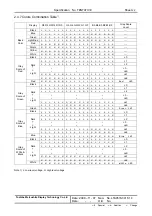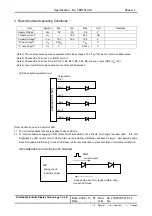
Specification No. TENTATIVE
Sheet
9
Toshiba Matsushita Display Technology Co.,Ltd
Date: 2008 – 11- 07
Date: - -
New No. LTA057A341F-14
Old No.
←
# Special
←&
Addition
←
Change
∗
3) PREVENTION FOR SCRATCHES ON A DISPLAY
Be careful not to touch a module display with hard things, such as a tool etc., press a module display with them or
rub a module display with them.
Moreover, be careful not to put heavy things, such as a tool etc., or pile up LCD module displays.
As polarizing plates used for a display is easy to be damaged, it may cause scratches, trace, or breakage of the plate.
∗
4) HANDLING THE REAR OF A LCD MODULE
There are mechanically weak parts, such as a circuit board etc. in the LCD module rear shown in oblique lines
portion of the drawing below.
Be careful that circuit and parts may be damaged and a LCD module may fail if applying stress when assembling a
LCD module in a set or handling it.
5) HOW TO INSERT CONNECTOR
Be careful not to apply a strong external force on the connector of a LCD module when inserting or removing cables
to connectors of a module. A strong external force may damage internal connections of PCB or TAB driver.
Insert them correctly so that connectors for LCD module input signals and connection connectors of a set are not
inserted oblique or half, and be sure to check them.
When inputting signals etc. without inserting them correctly, it may cause failures of circuit parts.
6) HANDLING FPC
Be careful not to pull FPC or damage FPC. It causes failures.
3-6 OPERATION
Be sure that the following caution should be taken under assembly and inspection of the system.
1) POWER SUPPLY WHILE WORKING/ASSEMBLING
Be sure to turn off the power of a set while working. Pulling out and inserting a LCD module connector with the
power of a set turned on may damage a LCD module electric circuit. When turning on the power in a testing
process, an inspection process etc., use the power supply and input signals for a drive unit which satisfy the power
supply sequence described in this Specification.
2) INPUT SIGNAL
The signal should be applied after power supplies are turned on.
The signal should be removed before power supplies are turned off.
The detailed sequence of power supplies and signals are described in this specifications.











































